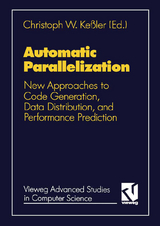Automatic Parallelization
Vieweg & Teubner (Verlag)
978-3-528-05401-4 (ISBN)
2 The Weight Finder - An Advanced Profiler for Fortran Programs.- 2.1 Introduction.- 2.2 Prerequisite.- 2.3 The Weight Finder.- 2.4 Adaptation of Profile Data.- 2.5 Conclusion and Future Work.- 3 Predicting Execution Times of Sequential Scientific Kernels.- 3.1 Motivation.- 3.2 Deriving time formulae for code fragments.- 3.3 Obtaining a platform model.- 3.4 Examples.- 3.5 Discussion and Further Work.- 4 Isolating the Reasons for the Performance of Parallel Machines on Numerical Programs.- 4.1 Introduction.- 4.2 Micro Measurements.- 4.3 Measurements.- 4.4 Algorithms.- 4.5 Analysis of the Programs.- 4.6 Conclusion.- 5 Targeting Transputer Systems, Past and Future.- 5.1 Introduction.- 5.2 The T800 family.- 5.3 The T9000 family.- 5.4 The Chameleon family.- 6 Adaptor: A Compilation System for Data Parallel Fortran Programs.- 6.1 Introduction.- 6.2 The Adaptor Compilation System.- 6.3 Results of Benchmark Codes.- 6.4 Results of Application Codes.- 6.5 Summary.- 7 SNAP! Prototyping a Sequential and Numerical Application Parallelizer.- 7.1 Introduction.- 7.2 Compiler.- 7.3 Conclusions.- 8 Knowledge-Based Automatic Parallelization by Pattern Recognition.- 8.1 Introduction and Overview.- 8.2 Preprocessing the Source Code.- 8.3 Which Patterns are Supported?.- 8.4 Pattern Recognition: A Detailed View.- 8.5 A Parallel Algorithm for each Pattern.- 8.6 Alignment and Partitioning.- 8.7 Determining Cost Functions: Estimating and Benchmarking.- 8.8 Implementation and Future Extensions.- 8.9 Conclusions.- 9 Automatic Data Layout for Distributed-Memory Machines in the D Programming Environment.- 9.1 Introduction.- 9.2 Compilation system.- 9.3 Dynamic Data Layout: Two Examples.- 9.4 Towards Dynamic Data Layout.- 9.5 Related Work.- 9.6 Summary and Future Work.- 10 SubspaceOptimizations.- 10.1 Introduction.- 10.2 Subspaces.- 10.3 Subspace Changes.- 10.4 Subspace Optimizations.- 10.5 Subspaces Optimization Compared to Alignment.- 10.6 Summary.- 10.7 Acknowledgments.- 11 Data and Process Alignment in Modula-2*.- 11.1 Introduction.- 11.2 Modula-2*.- 11.3 Alignment in Modula-2*.- 11.4 Arrangement Graphs and Conflicts.- 11.5 Cost Considerations.- 11.6 Example.- 11.7 Conclusion.- 12 Automatic Parallelization for Distributed Memory Multiprocessors.- 12.1 Introduction.- 12.2 Related Work.- 12.3 Overview.- 12.4 Parallelization Strategy.- 12.5 Branch-and-Bound Algorithm.- 12.6 Performance Estimator.- 12.7 Prototype Implementation and Results.- 12.8 Conclusions and Further Research.- 12.9 Acknowledgements.- A Trademarks.
| Erscheint lt. Verlag | 1.1.1994 |
|---|---|
| Reihe/Serie | Vieweg Advanced Studies in Computer Science |
| Zusatzinfo | XI, 224 p. |
| Verlagsort | Wiesbaden |
| Sprache | englisch |
| Maße | 148 x 210 mm |
| Gewicht | 317 g |
| Themenwelt | Informatik ► Theorie / Studium ► Kryptologie |
| Schlagworte | algorithms • Benchmarking • Code • Communication • Control • FORTRAN • Management • Multiprozessor • Networks • Optimization • Parallelrechner • pattern recognition • Performance • Processing • programming • Scala • Time |
| ISBN-10 | 3-528-05401-8 / 3528054018 |
| ISBN-13 | 978-3-528-05401-4 / 9783528054014 |
| Zustand | Neuware |
| Haben Sie eine Frage zum Produkt? |
aus dem Bereich




